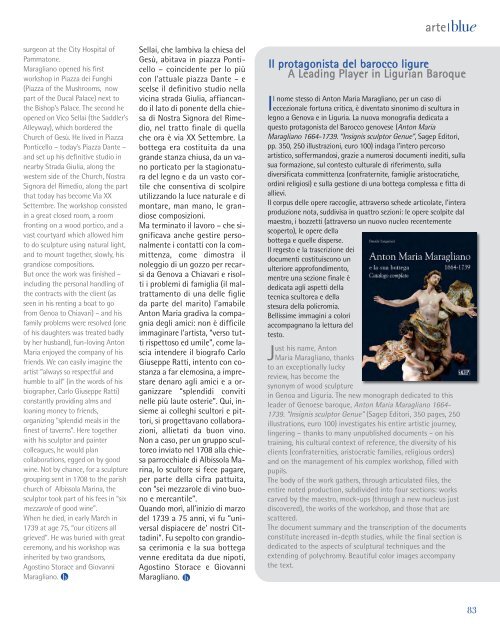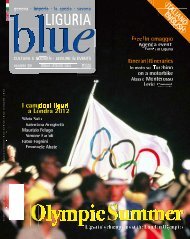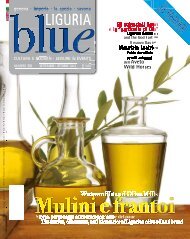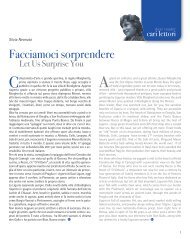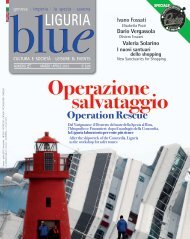BLUE NEW 31_215x270 - Blue Liguria - Sagep
BLUE NEW 31_215x270 - Blue Liguria - Sagep
BLUE NEW 31_215x270 - Blue Liguria - Sagep
You also want an ePaper? Increase the reach of your titles
YUMPU automatically turns print PDFs into web optimized ePapers that Google loves.
arte<br />
blue<br />
surgeon at the City Hospital of<br />
Pammatone.<br />
Maragliano opened his first<br />
workshop in Piazza dei Funghi<br />
(Piazza of the Mushrooms, now<br />
part of the Ducal Palace) next to<br />
the Bishop’s Palace. The second he<br />
opened on Vico Sellai (the Saddler’s<br />
Alleyway), which bordered the<br />
Church of Gesù. He lived in Piazza<br />
Ponticello – today’s Piazza Dante –<br />
and set up his definitive studio in<br />
nearby Strada Giulia, along the<br />
western side of the Church, Nostra<br />
Signora del Rimedio, along the part<br />
that today has become Via XX<br />
Settembre. The workshop consisted<br />
in a great closed room, a room<br />
fronting on a wood portico, and a<br />
vast courtyard which allowed him<br />
to do sculpture using natural light,<br />
and to mount together, slowly, his<br />
grandiose compositions.<br />
But once the work was finished –<br />
including the personal handling of<br />
the contracts with the client (as<br />
seen in his renting a boat to go<br />
from Genoa to Chiavari) – and his<br />
family problems were resolved (one<br />
of his daughters was treated badly<br />
by her husband), fun-loving Anton<br />
Maria enjoyed the company of his<br />
friends. We can easily imagine the<br />
artist “always so respectful and<br />
humble to all” (in the words of his<br />
biographer, Carlo Giuseppe Ratti)<br />
constantly providing alms and<br />
loaning money to friends,<br />
organizing “splendid meals in the<br />
finest of taverns”. Here together<br />
with his sculptor and painter<br />
colleagues, he would plan<br />
collaborations, egged on by good<br />
wine. Not by chance, for a sculpture<br />
grouping sent in 1708 to the parish<br />
church of Albissola Marina, the<br />
sculptor took part of his fees in “six<br />
mezzarole of good wine”.<br />
When he died, in early March in<br />
1739 at age 75, “our citizens all<br />
grieved”. He was buried with great<br />
ceremony, and his workshop was<br />
inherited by two grandsons,<br />
Agostino Storace and Giovanni<br />
Maragliano.<br />
Sellai, che lambiva la chiesa del<br />
Gesù, abitava in piazza Ponticello<br />
– coincidente per lo più<br />
con l’attuale piazza Dante – e<br />
scelse il definitivo studio nella<br />
vicina strada Giulia, affiancando<br />
il lato di ponente della chiesa<br />
di Nostra Signora del Rimedio,<br />
nel tratto finale di quella<br />
che ora è via XX Settembre. La<br />
bottega era costituita da una<br />
grande stanza chiusa, da un vano<br />
porticato per la stagionatura<br />
del legno e da un vasto cortile<br />
che consentiva di scolpire<br />
utilizzando la luce naturale e di<br />
montare, man mano, le grandiose<br />
composizioni.<br />
Ma terminato il lavoro – che significava<br />
anche gestire personalmente<br />
i contatti con la committenza,<br />
come dimostra il<br />
noleggio di un gozzo per recarsi<br />
da Genova a Chiavari e risolti<br />
i problemi di famiglia (il maltrattamento<br />
di una delle figlie<br />
da parte del marito) l’amabile<br />
Anton Maria gradiva la compagnia<br />
degli amici: non è difficile<br />
immaginare l’artista, “verso tutti<br />
rispettoso ed umile”, come lascia<br />
intendere il biografo Carlo<br />
Giuseppe Ratti, intento con costanza<br />
a far elemosina, a imprestare<br />
denaro agli amici e a organizzare<br />
“splendidi conviti<br />
nelle più laute osterie”. Qui, insieme<br />
ai colleghi scultori e pittori,<br />
si progettavano collaborazioni,<br />
allietati da buon vino.<br />
Non a caso, per un gruppo scultoreo<br />
inviato nel 1708 alla chiesa<br />
parrocchiale di Albissola Marina,<br />
lo scultore si fece pagare,<br />
per parte della cifra pattuita,<br />
con “sei mezzarole di vino buono<br />
e mercantile”.<br />
Quando morì, all’inizio di marzo<br />
del 1739 a 75 anni, vi fu “universal<br />
dispiacere de’ nostri Cittadini”.<br />
Fu sepolto con grandiosa<br />
cerimonia e la sua bottega<br />
venne ereditata da due nipoti,<br />
Agostino Storace e Giovanni<br />
Maragliano.<br />
Il protagonista del barocco ligure<br />
A Leading Player in <strong>Liguria</strong>n Baroque<br />
Il nome stesso di Anton Maria Maragliano, per un caso di<br />
eccezionale fortuna critica, è diventato sinonimo di scultura in<br />
legno a Genova e in <strong>Liguria</strong>. La nuova monografia dedicata a<br />
questo protagonista del Barocco genovese (Anton Maria<br />
Maragliano 1664-1739. “Insignis sculptor Genue”, <strong>Sagep</strong> Editori,<br />
pp. 350, 250 illustrazioni, euro 100) indaga l’intero percorso<br />
artistico, soffermandosi, grazie a numerosi documenti inediti, sulla<br />
sua formazione, sul contesto culturale di riferimento, sulla<br />
diversificata committenza (confraternite, famiglie aristocratiche,<br />
ordini religiosi) e sulla gestione di una bottega complessa e fitta di<br />
allievi.<br />
Il corpus delle opere raccoglie, attraverso schede articolate, l’intera<br />
produzione nota, suddivisa in quattro sezioni: le opere scolpite dal<br />
maestro, i bozzetti (attraverso un nuovo nucleo recentemente<br />
scoperto), le opere della<br />
bottega e quelle disperse.<br />
Il regesto e la trascrizione dei<br />
documenti costituiscono un<br />
ulteriore approfondimento,<br />
mentre una sezione finale è<br />
dedicata agli aspetti della<br />
tecnica scultorea e della<br />
stesura della policromia.<br />
Bellissime immagini a colori<br />
accompagnano la lettura del<br />
testo.<br />
Just his name, Anton<br />
Maria Maragliano, thanks<br />
to an exceptionally lucky<br />
review, has become the<br />
synonym of wood sculpture<br />
in Genoa and <strong>Liguria</strong>. The new monograph dedicated to this<br />
leader of Genoese baroque, Anton Maria Maragliano 1664-<br />
1739. “Insignis sculptor Genue” (<strong>Sagep</strong> Editori, 350 pages, 250<br />
illustrations, euro 100) investigates his entire artistic journey,<br />
lingering – thanks to many unpublished documents – on his<br />
training, his cultural context of reference, the diversity of his<br />
clients (confraternities, aristocratic families, religious orders)<br />
and on the management of his complex workshop, filled with<br />
pupils.<br />
The body of the work gathers, through articulated files, the<br />
entire noted production, subdivided into four sections: works<br />
carved by the maestro, mock-ups (through a new nucleus just<br />
discovered), the works of the workshop, and those that are<br />
scattered.<br />
The document summary and the transcription of the documents<br />
constitute increased in-depth studies, while the final section is<br />
dedicated to the aspects of sculptural techniques and the<br />
extending of polychromy. Beautiful color images accompany<br />
the text.<br />
83


